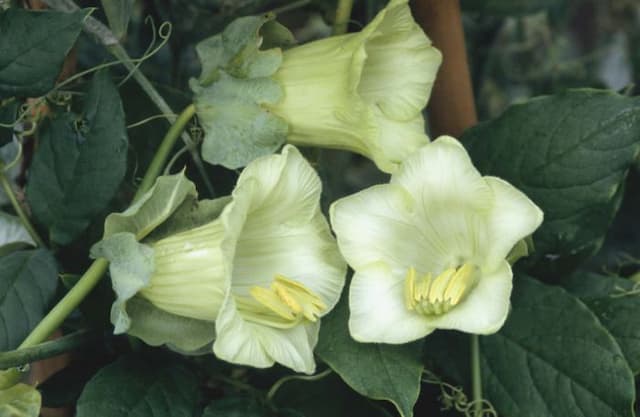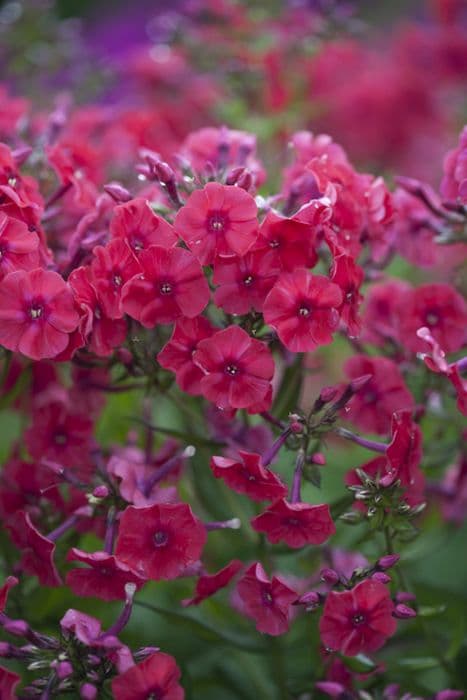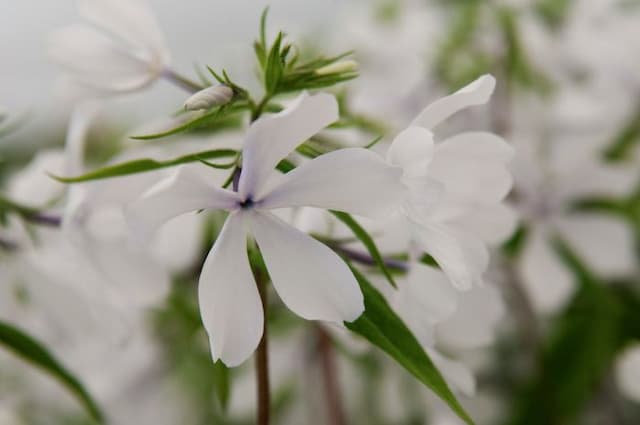Perennial phlox 'Prospero' Phlox paniculata 'Prospero'

ABOUT
'Prospero' is an herbaceous perennial to 90cm tall, with dark green lance-shaped leaves and terminal panicles of fragrant, white-eyed, light lilac-purple flowers with pale-edged petals, in early summer
About this plant
 Names
NamesFamily
Polemoniaceae
Synonyms
Garden Phlox, Summer Phlox, Fall Phlox, Perennial Phlox
Common names
Phlox paniculata 'Prospero'.
 Characteristics
CharacteristicsLife cycle
Perennials
Foliage type
Deciduous
Color of leaves
Green
Flower color
Lavender
Height
3-4 feet (0.9-1.2 meters)
Spread
2-3 feet (0.6-0.9 meters)
Plant type
Herb
Hardiness zones
4-8
Native area
Eastern United States
Benefits
 General Benefits
General Benefits- Attracts Pollinators: Draws in bees, butterflies, and other beneficial insects, promoting biodiversity in the garden.
- Easy to Grow: Known for being low-maintenance and tolerant of a variety of soil conditions.
- Long Blooming: Provides colorful blooms from mid to late summer, enhancing garden aesthetics for an extended period.
- Drought Tolerant: Once established, it can withstand periods of dry weather, reducing the need for frequent watering.
- Deer Resistant: Less prone to browsing by deer, which can be beneficial in areas where deer predation is a problem for gardeners.
- Fragrant: Offers a pleasing fragrance that can enhance the sensory experience of a garden or landscape.
- Cut Flowers: Suitable for cutting and use in floral arrangements, bringing the beauty of the garden indoors.
- Versatile: Fits well in borders, cottage gardens, and a variety of garden designs for visual appeal.
 Medical Properties
Medical PropertiesThis plant is not used for medical purposes.
 Air-purifying Qualities
Air-purifying QualitiesThis plant is not specifically known for air purifying qualities.
 Other Uses
Other Uses- Garden Phlox dye: The blossoms of Garden Phlox can be used to create a natural dye for fabrics, providing hues of pink and purple depending on the mordant used.
- Pressed flower crafts: The flowers of Garden Phlox, with their vibrant colors, can be pressed and used in creating bookmarks, greeting cards, and other decorative crafts.
- Garden aesthetics: Garden Phlox can be planted alongside garden paths or in mass plantings to enhance the visual appeal and create a dramatic statement in garden design.
- Photography prop: Due to its striking appearance, Garden Phlox often serves as a beautiful subject for photography, adding color and interest to botanical and garden-themed photo shoots.
- Luminous garden scenes: Some varieties of Garden Phlox, including phosphorescent or light-colored blooms, can create a glowing effect in moon gardens designed to be enjoyed at twilight or in the evening.
- Educational tool: The various growth stages of Garden Phlox can serve as an educational tool in gardening workshops, teaching about plant life cycles, pollination, and horticulture techniques.
- Event decorations: The attractive clusters of Garden Phlox blooms are sometimes used as natural decorations for garden parties, weddings, or other outdoor events.
- Companion planting: Garden Phlox can be used as companion plants for vegetables, potentially attracting beneficial insects or providing a visual guide for crop rows.
- Plant swap: Garden Phlox is a popular plant for local plant swap events among gardeners looking to diversify their gardens with hardy perennials.
- Petal confetti: The petals of Garden Phlox can be used as biodegradable confetti for outdoor celebrations, adding a splash of color without harming the environment.
Interesting Facts
 Feng Shui
Feng ShuiGarden Phlox is not used in Feng Shui practice.
 Zodiac Sign Compitability
Zodiac Sign CompitabilityGarden Phlox is not used in astrology practice.
 Plant Symbolism
Plant Symbolism- Harmony - Phlox in general symbolizes harmony and unity, due to its clusters of flowers that cohesively form a single beautiful bush.
- Agreement - Their unified flowering heads often represent agreement or coming together in society or in personal relationships.
- Proposal - The Phlox is sometimes associated with proposals or offers in romance, owing to its appealing aesthetic and pleasant fragrance.
- Sweet Dreams - In the language of flowers, Phlox can symbolize the wish for pleasant or sweet dreams – an ideal gift for someone in need of restful nights or to calm worries.
 Water
WaterGarden Phlox should be watered thoroughly once a week, providing about an inch of water which equates to roughly 0.6 gallons per square yard of soil. During hot or dry spells, increase watering to twice per week. Water at ground level to avoid wetting the foliage, as damp leaves can promote disease. Make sure the soil drains well and does not remain waterlogged, which can harm the plant's roots. Adjust the watering schedule according to the rainfall in your area to maintain consistent soil moisture.
 Light
LightGarden Phlox thrives in full sun, requiring at least six hours of direct sunlight per day. Partial shade is also tolerable, especially in regions with intense midday sun. The best spot for planting Garden Phlox would be an area where it can receive morning sunlight and protection from the harsh afternoon sun, particularly in hotter climates.
 Temperature
TemperatureGarden Phlox prefers moderate temperatures and can survive in a temperature range of about 60°F to 86°F, but it can also withstand slightly cooler and warmer temperatures. It benefits from cooler temperatures at night and during the early morning. The ideal temperature range for Garden Phlox to thrive is approximately 64°F to 75°F, avoiding the extremes of freezing temperatures and the scorching heat.
 Pruning
PruningTo maintain the health and appearance of Garden Phlox, prune in early spring to promote vigorous growth. Cut back winter-damaged stems to about one to two inches above ground level. Deadhead spent flowers regularly to encourage new blooms and to prevent self-seeding, which can result in weaker plants. Pruning may also involve thinning out stems to improve air circulation, which helps prevent powdery mildew.
 Cleaning
CleaningAs needed
 Soil
SoilGarden Phlox (Phlox paniculata 'Prospero') thrives in rich, well-drained soil with a slightly acidic to neutral pH of 6.0 to 7.0. A soil mix containing garden loam, compost, and peat moss with adequate drainage is ideal for this perennial.
 Repotting
RepottingGarden Phlox typically does not require frequent repotting as it is usually grown in the ground. Dividing the clumps every 3 to 4 years in spring or fall can rejuvenate growth.
 Humidity & Misting
Humidity & MistingGarden Phlox prefers moderate humidity but is quite adaptable and can thrive in the humidity levels typically found in garden environments.
 Suitable locations
Suitable locationsIndoor
Place in bright, indirect light and ensure good air circulation.
Outdoor
Choose sunny spot with moist, well-drained soil, and space for air flow.
Hardiness zone
4-8 USDA
 Life cycle
Life cyclePhlox paniculata 'Prospero', commonly known as Garden Phlox, begins its life cycle when seeds germinate in early spring, requiring a period of cold stratification to break dormancy. Seedlings emerge and grow into vegetative plants, forming a mound of foliage. As temperatures increase, stems elongate, and the plants enter the flowering phase by mid to late summer, producing clusters of fragrant, lavender-pink flowers that attract pollinators. After pollination, flowers develop into seed capsules, which mature and release seeds in late summer to fall. The plant dies back to the ground after frost, with the root system remaining dormant over winter. In the following spring, Garden Phlox regrows from the existing rootstock, repeating its lifecycle.
 Propogation
PropogationPropogation time
Spring to early summer
Propogation: The most popular method of propagating garden phlox, which is the common name for Phlox paniculata 'Prospero', is through stem cuttings. Typically, propagation time is in the spring after the last frost, or in the summer. For taking cuttings, gardeners should select a healthy stem and cut a 4- to 6-inch (approximately 10 to 15 cm) length, just below a node. The lower leaves are then removed, and the cut end may be dipped in rooting hormone to encourage root development. The cutting is then placed in a well-draining soil mix, ensuring at least one node is below the surface. Cuttings should be kept moist but not waterlogged, and in a warm area with indirect light. Roots usually develop within a few weeks, after which the new garden phlox plants can be gradually acclimatized to outdoor conditions before transplanting.









